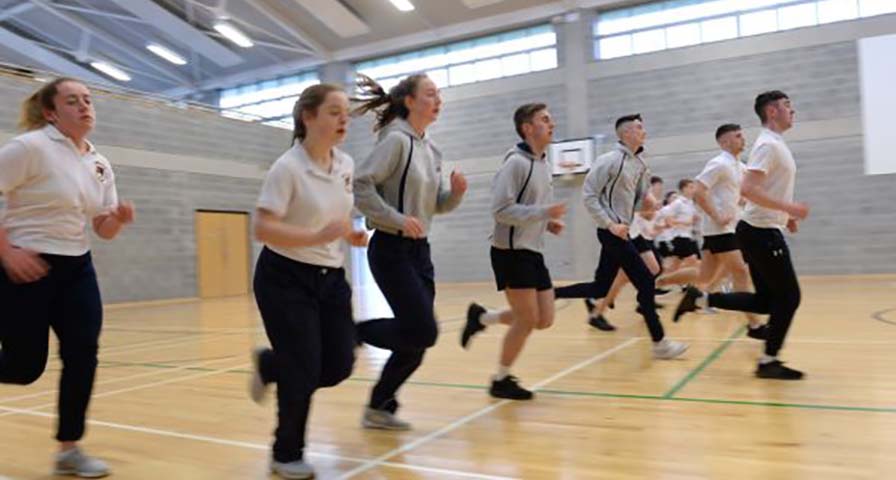Originally published May 8, 2019 in The Irish Times.
By Niamh Griffin
How to keep girls in sport is a contentious topic, but it’s starting to look like everyone has the wrong end of the stick. Instead of talking about medals, we should be looking at different ways of being active.
Proof of this is in the quiet revolution happening in Irish schools, and it’s not just about the new Leaving Certificate Physical Education classes.
 Making PE an exam subject was a hugely important move. But re-vamping the curriculum in non-exam PE classes to finally recognise that lots of girls (and boys) don’t like ball sports is even bigger. Because, whisper it, some girls want to be active but just don’t want to play on a team.
Making PE an exam subject was a hugely important move. But re-vamping the curriculum in non-exam PE classes to finally recognise that lots of girls (and boys) don’t like ball sports is even bigger. Because, whisper it, some girls want to be active but just don’t want to play on a team.
Sport Ireland found eight of the top ten most popular sports played in Ireland are individual ones including cycling, running, yoga and dance. The new Senior Cycle PE includes these in classes designed for and by students who are looking for activity and knowledge about their bodies.
Coming after the madness of the Celtic Tiger years when gym membership costs hit stratospheric levels, it is vital this programme gets rolled out beyond the current 80 schools. We can’t fight Ireland’s rising obesity levels without inspiring teenagers to want to move.
So, while it’s important some students now get to take PE for exams, it shouldn’t be our only focus. For students who are already in love with sport, it is a chance to get college points for their efforts. It is something they were denied while academic children and musical students ramped up their points doing something they enjoyed.
But the real sea-change is outside the exam classes. In classrooms where many PE teachers naturally gravitate to team sports because of their backgrounds, everyone is now reaching for new ideas.
Tony McSweeney from the Physical Education Association of Ireland said it was a revelation to a girl in one of his classes that her daily walks are exercise. She was thrilled to realise she’s not a dreaded couch potato.
Who knows what she will try next, now she’s no longer labelled as “not sporty”?
McSweeney can now offer his skills as a trained martial arts instructor as an option for his Cork students to vote on and include in their studies. Specific martial arts are not named in the programme’s framework, but they can be studied depending on a teacher’s skills. This opens the possibility of teaching Olympic sports like judo or karate as well as less well-known sports.
It’s not that ball games are deleted; they are there but girls can look elsewhere as well. The Adventure Education topic draws links between outdoor sport and the environment. Dance is suggested as slotting into Sport Education or Teaching Games for Understanding.
And in another radical move, students look at roles other than as players in sports.
Prof Deborah Tannehill at the University of Limerick says watching girls take on coaching their peers has been one of the joys of working with schools on this programme.
She mentions a girl who took over the equipment discussions for her group and produced elaborate patches for the team shirts. So that’s a girl who now has positive associations with sport, again that could take her anywhere.
Other topics allow girls to discuss where they fit into sport. Contemporary Issues in Physical Activity includes examining the role of gender in accessing fitness, and the role of the media in promoting sportswomen.
Dylan Scanlon is writing a PhD on the changes, working with schools in Limerick and Dublin. He says the students’ and teachers’ enthusiasm is what stands out; explaining the classes reach 90 percent of students who don’t usually play on the school camogie or hockey teams. It’s a validation for their passions.
And interestingly he says industry fears that the exam classes would be dominated by boys are not playing out. In his experience, the classes are almost 50/50 boys and girls.
But a lot of investment and support is needed to push this programme into every school.
Schools are assessing their access to technology as well as the time teachers need to bed this in.
Leaving Cert PE is heavily dependent on technology with marks for a digital portfolio and video-recording sports performance for self-assessment. This means students need access to a tablet device. So, for schools where the internal wifi doesn’t quite reach the sports hall not to mind buying tablets, that’s a challenge.
And it will be a challenge for the Department of Education to maintain a level playing field between schools with different income levels.
National sports organisations need to get involved so these changes ripple into the community. They can support both subjects; sports studied for the exam must be under a recognised National Governing Body.
Cycling Ireland is one group already doing good work. Invited into a Limerick school by students, they organised bike maintenance lessons as well as sports instruction. Again, it’s not all competition, it’s about staying active.
For teachers, it’s a new way of working. They’re taking advice from their students about the sports to pick. There is no set textbook so they are creating materials from scratch for the 128 learning outcomes on the curriculum. That’s a lot of stapling and cutting.
There is learning for the girls also. They are choosing activities, taking responsibility for being healthy. That is fun, but they cannot just sit at the back and moan; this is their subject now.
Girls can be just as competitive as boys but forcing them to do sports they don’t like has not worked out.
This new programme is stepping away from the one-shoe-fits-all approach and turning to activity instead of pure sport. It just might be the solution we didn’t know we needed.
Seeking IHT Spirit System information?




